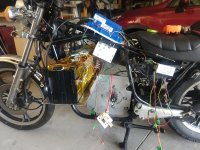griffondude
1 mW
Good day everyone. I am building an E Motorcycle from an old 1983 Suzuki GS450L. The core of the project is this kit: Home :: Motorcycle & Kart Kits :: Budget Screamer (28KW, 72V Brushed). I am using 2 hybrid bus BAE batteries in series to make 80V. The project has been rideable since last summer but it's not polished enough to be inspected and insured yet. The motorcycle rides quite nicely!
I am using a DC to DC converter to get 12V power for all the basic chassis electrical services. There is no 12V battery at this time, although that could change if required by local laws.
My only question is: The DC-DC converter uses a common negative (ground) for the 12V and 80V circuits. I decided to wire it to the negative terminal of the 80V battery, after the BMS. It seems to work ok but I could swear it changed the behaviour of the motor when throttle is chopped. It now seems to give a little kick before powering off. Any ideas why that would be? I'm not in love with this common ground idea because I was hoping to keep the two systems separate.
Thanks in advance.
I am using a DC to DC converter to get 12V power for all the basic chassis electrical services. There is no 12V battery at this time, although that could change if required by local laws.
My only question is: The DC-DC converter uses a common negative (ground) for the 12V and 80V circuits. I decided to wire it to the negative terminal of the 80V battery, after the BMS. It seems to work ok but I could swear it changed the behaviour of the motor when throttle is chopped. It now seems to give a little kick before powering off. Any ideas why that would be? I'm not in love with this common ground idea because I was hoping to keep the two systems separate.
Thanks in advance.





